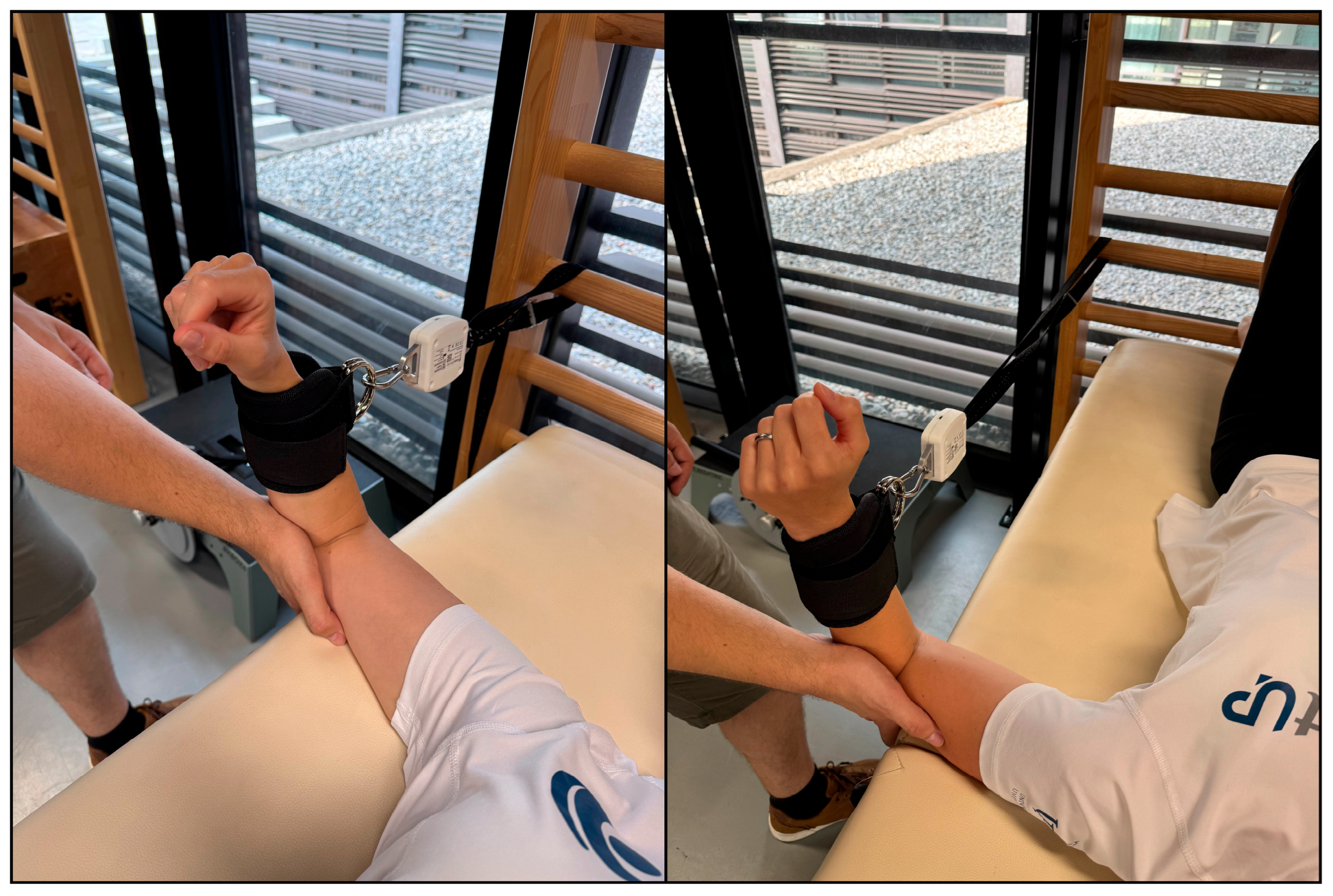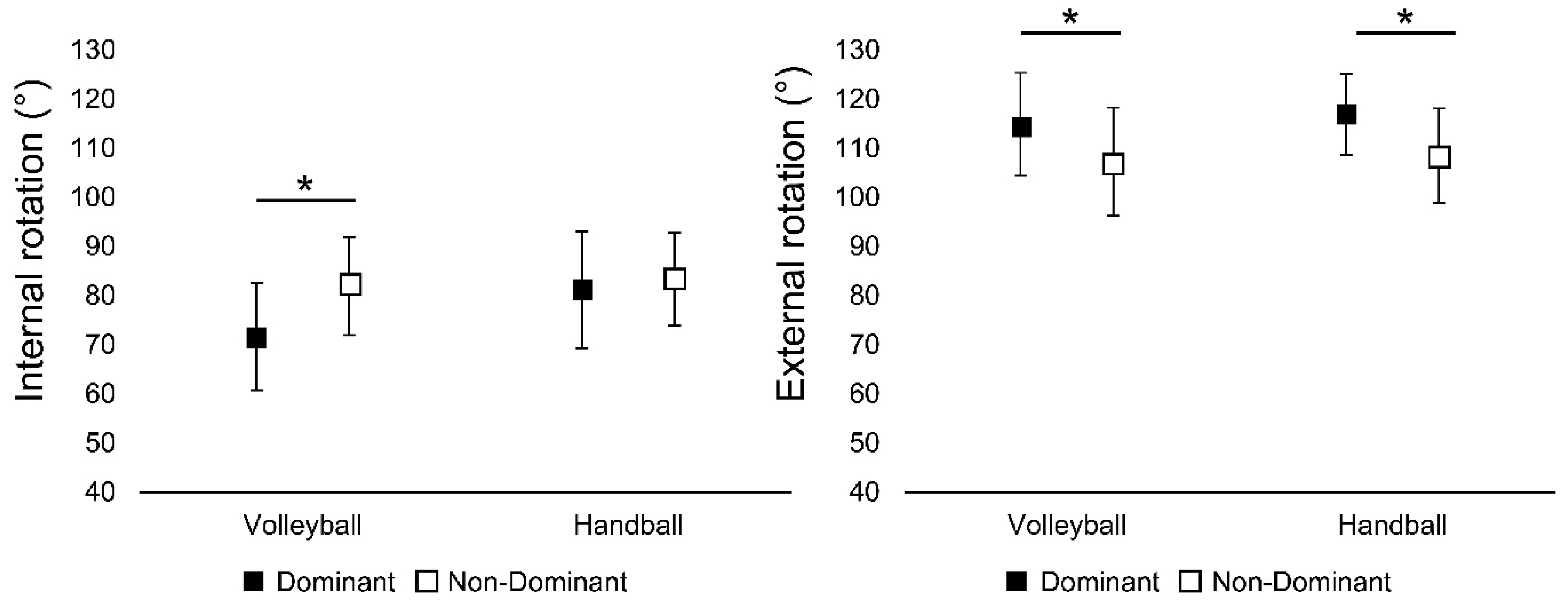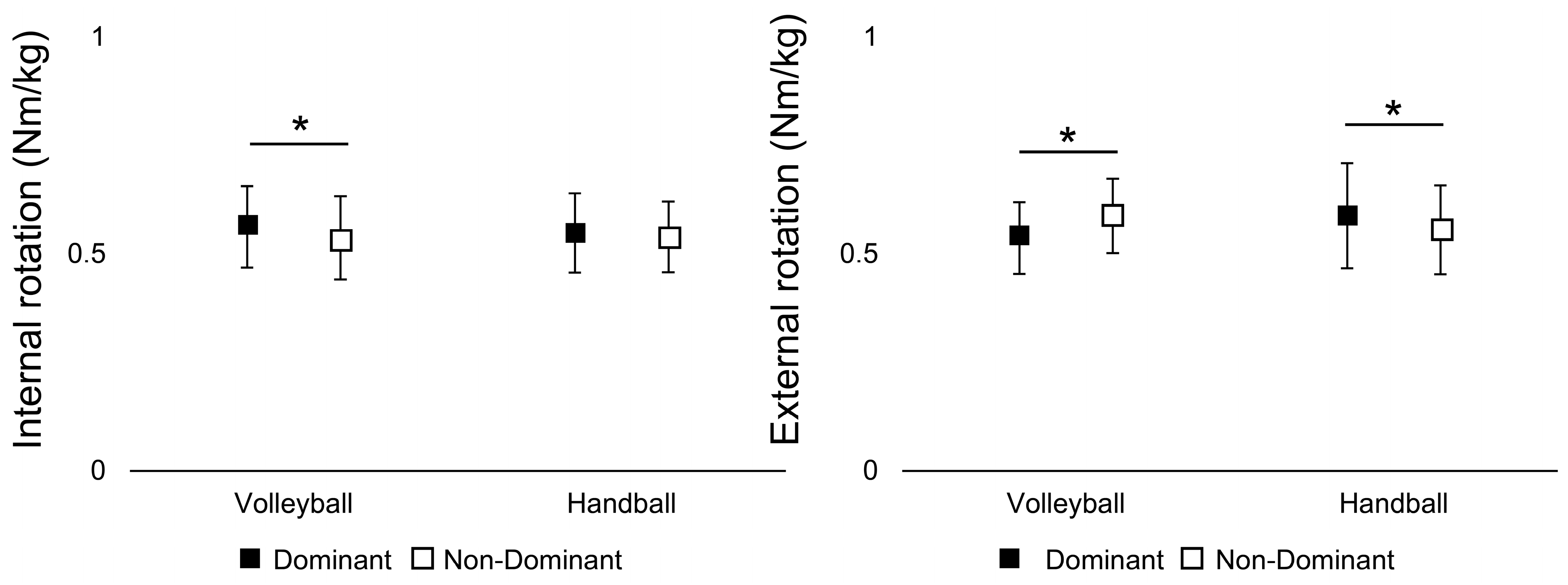Sport-Specific Shoulder Rotator Adaptations: Strength, Range of Motion, and Asymmetries in Female Volleyball and Handball Athletes
Abstract
1. Introduction
2. Materials and Methods
2.1. Participants
2.2. Study Design
2.3. Range of Motion Assessment
2.4. Strength Assessment
2.5. Statistical Analysis
3. Results
3.1. Reliability
3.2. Range of Motion
3.3. Maximal Strength
3.4. ER:IR Ratio
4. Discussion
5. Conclusions
Author Contributions
Funding
Institutional Review Board Statement
Data Availability Statement
Conflicts of Interest
Abbreviations
| BMI | Body Mass Index |
| CoP | Center of Pressure |
| ER | External Rotation |
| ER:IR | External-to-Internal Rotation Strength Ratio |
| HG | Handball Group |
| ICC | Intraclass Correlation Coefficient |
| IR | Internal Rotation |
| MVC | Maximal Voluntary Contraction |
| RoM | Range of Motion |
| VG | Volleyball Group |
References
- Wolfe, H.; Poole, K.; Villasante Tezanos, A.G.; English, R.; Uhl, T.L. Volleyball Overhead Swing Volume and Injury Frequency Over the Course of a Season. Int. J. Sports Phys. Ther. 2019, 14, 88–96. [Google Scholar] [CrossRef]
- Skazalski, C.; Bahr, R.; Whiteley, R. Shoulder Complaints More Likely in Volleyball Players with a Thickened Bursa or Supraspinatus Tendon Neovessels. Scand. J. Med. Sci. Sports 2021, 31, 480–488. [Google Scholar] [CrossRef]
- Andersson, S.H.; Bahr, R.; Clarsen, B.; Myklebust, G. Preventing Overuse Shoulder Injuries among Throwing Athletes: A Cluster-Randomised Controlled Trial in 660 Elite Handball Players. Br. J. Sports Med. 2017, 51, 1073–1080. [Google Scholar] [CrossRef]
- Hadjisavvas, S.; Efstathiou, M.A.; Malliou, V.; Giannaki, C.D.; Stefanakis, M. Risk Factors for Shoulder Injuries in Handball: Systematic Review. BMC Sports Sci. Med. Rehabil. 2022, 14, 204. [Google Scholar] [CrossRef]
- Hadzic, V.; Sattler, T.; Veselko, M.; Markovic, G.; Dervisevic, E. Strength Asymmetry of the Shoulders in Elite Volleyball Players. J. Athl. Train. 2014, 49, 338–344. [Google Scholar] [CrossRef]
- Noffal, G.J. Isokinetic Eccentric-to-Concentric Strength Ratios of the Shoulder Rotator Muscles in Throwers and Nonthrowers. Am. J. Sports Med. 2003, 31, 537–541. [Google Scholar] [CrossRef] [PubMed]
- Wang, H.K.; Macfarlane, A.; Cochrane, T. Isokinetic Performance and Shoulder Mobility in Elite Volleyball Athletes from the United Kingdom. Br. J. Sports Med. 2000, 34, 39–43. [Google Scholar] [CrossRef] [PubMed]
- Ahmadi, S.; Gutierrez, G.L.; Uchida, M.C. Correlation between Handgrip and Isokinetic Strength of Shoulder Muscles in Elite Sitting Volleyball Players. J. Bodyw. Mov. Ther. 2020, 24, 159–163. [Google Scholar] [CrossRef]
- Cools, A.M.J.; Vanderstukken, F.; Vereecken, F.; Duprez, M.; Heyman, K.; Goethals, N.; Johansson, F. Eccentric and Isometric Shoulder Rotator Cuff Strength Testing Using a Hand-Held Dynamometer: Reference Values for Overhead Athletes. Knee Surg. Sports Traumatol. Arthrosc. 2016, 24, 3838–3847. [Google Scholar] [CrossRef]
- Bradley, H.; Pierpoint, L. Normative Values of Isometric Shoulder Strength Among Healthy Adults. Int. J. Sports Phys. Ther. 2023, 18, 977–988. [Google Scholar] [CrossRef] [PubMed]
- Ellenbecker, T.S.; Davies, G.J. The Application of Isokinetics in Testing and Rehabilitation of the Shoulder Complex. J. Athl. Train. 2000, 35, 338–350. [Google Scholar] [PubMed]
- Riemann, B.L.; Davies, G.J.; Ludwig, L.; Gardenhour, H. Hand-Held Dynamometer Testing of the Internal and External Rotator Musculature Based on Selected Positions to Establish Normative Data and Unilateral Ratios. J. Shoulder Elb. Surg. 2010, 19, 1175–1183. [Google Scholar] [CrossRef]
- Andrade, M.D.S.; Fleury, A.M.; de Lira, C.A.B.; Dubas, J.P.; da Silva, A.C. Profile of Isokinetic Eccentric-to-Concentric Strength Ratios of Shoulder Rotator Muscles in Elite Female Team Handball Players. J. Sports Sci. 2010, 28, 743–749. [Google Scholar] [CrossRef]
- Edouard, P.; Degache, F.; Oullion, R.; Plessis, J.Y.; Gleizes-Cervera, S.; Calmels, P. Shoulder Strength Imbalances as Injury Risk in Handball. Int. J. Sports Med. 2013, 34, 654–660. [Google Scholar] [CrossRef] [PubMed]
- Holt, K.L.; Raper, D.P.; Boettcher, C.E.; Waddington, G.S.; Drew, M.K. Hand-Held Dynamometry Strength Measures for Internal and External Rotation Demonstrate Superior Reliability, Lower Minimal Detectable Change and Higher Correlation to Isokinetic Dynamometry than Externally-Fixed Dynamometry of the Shoulder. Phys. Ther. Sport 2016, 21, 75–81. [Google Scholar] [CrossRef]
- Trajković, N.; Kozinc, Ž.; Smajla, D.; Šarabon, N. Interrater and Intrarater Reliability of the EasyForce Dynamometer for Assessment of Maximal Shoulder, Knee and Hip Strength. Diagnostics 2022, 12, 442. [Google Scholar] [CrossRef]
- Wollin, M.; Purdam, C.; Drew, M.K. Reliability of Externally Fixed Dynamometry Hamstring Strength Testing in Elite Youth Football Players. J. Sci. Med. Sport 2016, 19, 93–96. [Google Scholar] [CrossRef]
- Koo, T.K.; Li, M.Y. A Guideline of Selecting and Reporting Intraclass Correlation Coefficients for Reliability Research. J. Chiropr. Med. 2016, 15, 155–163. [Google Scholar] [CrossRef]
- Lakens, D. Calculating and Reporting Effect Sizes to Facilitate Cumulative Science: A Practical Primer for t-Tests and ANOVAs. Front. Psychol. 2013, 4, 863. [Google Scholar] [CrossRef]
- Benda, P.; Nováková, T.; Žáková, L. Clinical Evaluation of Shoulder ROM in Volleyball and Handball Players in Youth Categories. AUC Kinanthropol. 2021, 57, 173–184. [Google Scholar] [CrossRef]
- Guney, H.; Harput, G.; Colakoglu, F.; Baltaci, G. The Effect of Glenohumeral Internal-Rotation Deficit on Functional Rotator-Strength Ratio in Adolescent Overhead Athletes. J. Sport Rehabil. 2016, 25, 52–57. [Google Scholar] [CrossRef]
- Harput, G.; Guney, H.; Toprak, U.; Kaya, T.; Colakoglu, F.F.; Baltaci, G. Shoulder-Rotator Strength, Range of Motion, and Acromiohumeral Distance in Asymptomatic Adolescent Volleyball Attackers. J. Athl. Train. 2016, 51, 733–738. [Google Scholar] [CrossRef]
- Schmalzl, J.; Walter, H.; Rothfischer, W.; Blaich, S.; Gerhardt, C.; Lehmann, L.-J. GIRD Syndrome in Male Handball and Volleyball Players: Is the Decrease of Total Range of Motion the Turning Point to Pathology? J. Back Musculoskelet. Rehabil. 2022, 35, 755–762. [Google Scholar] [CrossRef] [PubMed]
- Seabra, P.; Van Eck, C.F.; Sá, M.; Torres, J. Are Professional Handball Players at Risk for Developing a Glenohumeral Internal Rotation Deficit in Their Dominant Arm? Physician Sportsmed. 2017, 45, 77–81. [Google Scholar] [CrossRef]
- Reeser, J.C.; Fleisig, G.S.; Bolt, B.; Ruan, M. Upper Limb Biomechanics During the Volleyball Serve and Spike. Sports Health Multidiscip. Approach 2010, 2, 368–374. [Google Scholar] [CrossRef]
- Ceballos-Laita, L.; Pérez-Manzano, A.; Mingo-Gómez, T.; Hernando-Garijo, I.; Medrano-De-La-Fuente, R.; Estébanez-de-Miguel, E.; Jiménez-del-Barrio, S. Range of Motion and Muscle Function on Shoulder Joints of Young Handball Athletes. J. Back Musculoskelet. Rehabil. 2022, 35, 161–167. [Google Scholar] [CrossRef]
- Reeser, J.C.; Fleisig, G.S.; Cools, A.M.J.; Yount, D.; Magnes, S.A. Biomechanical Insights into the Aetiology of Infraspinatus Syndrome. Br. J. Sports Med. 2013, 47, 239–244. [Google Scholar] [CrossRef]
- Contemori, S.; Biscarini, A. Shoulder Position Sense in Volleyball Players with Infraspinatus Atrophy Secondary to Suprascapular Nerve Neuropathy. Scand. J. Med. Sci. Sports 2018, 28, 267–275. [Google Scholar] [CrossRef] [PubMed]
- Clarsen, B.; Bahr, R.; Andersson, S.H.; Munk, R.; Myklebust, G. Reduced Glenohumeral Rotation, External Rotation Weakness and Scapular Dyskinesis Are Risk Factors for Shoulder Injuries among Elite Male Handball Players: A Prospective Cohort Study. Br. J. Sports Med. 2014, 48, 1327–1333. [Google Scholar] [CrossRef]
- Kim, D.-K.; Park, G.; Kuo, L.-T.; Park, W.-H. Isokinetic Performance of Shoulder External and Internal Rotators of Professional Volleyball Athletes by Different Positions. Sci. Rep. 2020, 10, 8706. [Google Scholar] [CrossRef]
- Vigolvino, L.P.; Barros, B.R.S.; Medeiros, C.E.B.; Pinheiro, S.M.; Sousa, C.O. Analysis of the Presence and Influence of Glenohumeral Internal Rotation Deficit on Posterior Stiffness and Isometric Shoulder Rotators Strength Ratio in Recreational and Amateur Handball Players. Phys. Ther. Sport 2020, 42, 1–8. [Google Scholar] [CrossRef] [PubMed]




Disclaimer/Publisher’s Note: The statements, opinions and data contained in all publications are solely those of the individual author(s) and contributor(s) and not of MDPI and/or the editor(s). MDPI and/or the editor(s) disclaim responsibility for any injury to people or property resulting from any ideas, methods, instructions or products referred to in the content. |
© 2025 by the authors. Licensee MDPI, Basel, Switzerland. This article is an open access article distributed under the terms and conditions of the Creative Commons Attribution (CC BY) license (https://creativecommons.org/licenses/by/4.0/).
Share and Cite
Lenart, M.; Kozinc, Ž.; Čeklić, U. Sport-Specific Shoulder Rotator Adaptations: Strength, Range of Motion, and Asymmetries in Female Volleyball and Handball Athletes. Symmetry 2025, 17, 1211. https://doi.org/10.3390/sym17081211
Lenart M, Kozinc Ž, Čeklić U. Sport-Specific Shoulder Rotator Adaptations: Strength, Range of Motion, and Asymmetries in Female Volleyball and Handball Athletes. Symmetry. 2025; 17(8):1211. https://doi.org/10.3390/sym17081211
Chicago/Turabian StyleLenart, Manca, Žiga Kozinc, and Urška Čeklić. 2025. "Sport-Specific Shoulder Rotator Adaptations: Strength, Range of Motion, and Asymmetries in Female Volleyball and Handball Athletes" Symmetry 17, no. 8: 1211. https://doi.org/10.3390/sym17081211
APA StyleLenart, M., Kozinc, Ž., & Čeklić, U. (2025). Sport-Specific Shoulder Rotator Adaptations: Strength, Range of Motion, and Asymmetries in Female Volleyball and Handball Athletes. Symmetry, 17(8), 1211. https://doi.org/10.3390/sym17081211





